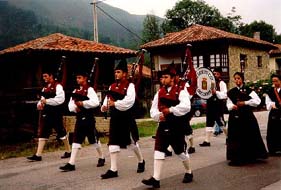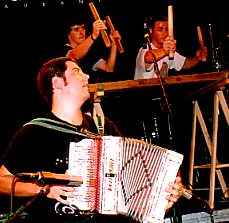FolkWorld article by Pio
Fernandez:
Spanish traditional and folk music in perspective
The image and the reality
THE "OLD" SPANISH TRADITIONAL MUSIC
For years (or lets say for centuries), the common image that the rest of Europe
had about the traditional music of Spain was unified under the concept of Flamenco:
Spanish guitar, clapping hands, tapping shoes, castanets, frenezied dancing,....
However, it must not be forgotten that Flamenco is the music of just the southern
Spanish region named Andalucia (Andalusia), although somehow it became the single
representative of the tradition of the whole country.
 The
big mistake is to consider that: "Well, maybe the other regions of Spain keep
a popular music not so different from the Andalusian flamenco, so lets say they
are all more or less flamenco music too". What I am going to say next is probably
nothing new to the readers of Folk World. The fact is that the traditional music
from Castilla (Castile, the central region of the peninsula), Catalonia, Aragon
and the Basque Country (neighbouring regions with France) for instance, do keep
many more similarities with the musics from Portugal, Southern France or Italy
than with Flamenco.
The
big mistake is to consider that: "Well, maybe the other regions of Spain keep
a popular music not so different from the Andalusian flamenco, so lets say they
are all more or less flamenco music too". What I am going to say next is probably
nothing new to the readers of Folk World. The fact is that the traditional music
from Castilla (Castile, the central region of the peninsula), Catalonia, Aragon
and the Basque Country (neighbouring regions with France) for instance, do keep
many more similarities with the musics from Portugal, Southern France or Italy
than with Flamenco.
Then, what made Flamenco so popular and significant in Spain and abroad? Probably
its exotic personality, strikingly different from the popular musics from Western
Europe but also from most of Spain. How did Flamenco get this distinctive character?
First, it is generally accepted that this music was probably brought into Spain
(maybe in a more primitive form) by nomad gypsies from India that travelled
west from there throughout Europe three or four centuries ago, finally settling
in Andalusia. And second, Andalusia is the part of Spain closer to the north
of Africa, where the cultural heritage of the moors that ruled Spain from 711
until 1492 was stronger and lasted longer. These two conditions favoured the
development along the centuries of a music with intense Oriental flavour. It
is easy to imagine the chronicles written by the romantic English, French, German
and Italian travellers, that two centuries ago arrived to that southern corner
of Europe. They found the legacy of the Arab architecture together with the
life style and traditions of the Andalusians, quite well reflected in the personality
of flamenco dancing and singing, and so started the myth of the "passionate
Spain".
 That
myth lasted until modern days, and it was well exploited during general Franco's
dictatorship (1939-1975), starting the Spanish tourist business boom of the
60's with the slogan: "Spain is different". And what could give us a look more
different to the rest of the Europeans than this hot-blooded Flamenco music
and dancing (put together with the bloody bullfighting tradition).
That
myth lasted until modern days, and it was well exploited during general Franco's
dictatorship (1939-1975), starting the Spanish tourist business boom of the
60's with the slogan: "Spain is different". And what could give us a look more
different to the rest of the Europeans than this hot-blooded Flamenco music
and dancing (put together with the bloody bullfighting tradition).
The fact is that the richness, passion and sophistication of flamenco music
and dancing made it appealing not just to the eyes of the foreign visitors (especially
from Japan!), but also developed fans in many other parts of Spain, where the
nomad Andalusian gypsies brought it with them. Outside Andalusia, flamenco could
never replace the local traditions of the other Spanish regions, but probably
could make them look duller.
THE "NEW" SPANISH FOLK MUSIC: THE CELTIC MUSIC BOOM
Then, how are these other forgotten musics of Spain? What is left from them?
 A
clear example of the differences between the Andalusian tradition and the ones
from the rest of Spain, is found in the northern regions of Galicia, Asturias
and North Castile. Over there, their ancient bagpipes have lasted as the most
representative instrument of their popular music. The kind of bagpipes played
there have a bass drone placed over the left shoulder of the piper, which was
the most typical configuration in central and northern European countries since
the middle ages. A tenor drone can be added, normally placed on the right side
of the bag. The sound of these instruments is certainly comparable to the bagpipes
from Scotland or France. The general Spanish name for these pipes is gaita,
although that name also designates other woodwinds without bag (with and without
reeds) played in several other Spanish regions. There are also bagpipes played
in neighbouring regions in southern France like Aragon, Catalonia and the Balearic
Isles. But over there the bass drone hangs from the front of the bag in a similar
fashion to the bagpipes from the south of France or the Italian zampogna.
A
clear example of the differences between the Andalusian tradition and the ones
from the rest of Spain, is found in the northern regions of Galicia, Asturias
and North Castile. Over there, their ancient bagpipes have lasted as the most
representative instrument of their popular music. The kind of bagpipes played
there have a bass drone placed over the left shoulder of the piper, which was
the most typical configuration in central and northern European countries since
the middle ages. A tenor drone can be added, normally placed on the right side
of the bag. The sound of these instruments is certainly comparable to the bagpipes
from Scotland or France. The general Spanish name for these pipes is gaita,
although that name also designates other woodwinds without bag (with and without
reeds) played in several other Spanish regions. There are also bagpipes played
in neighbouring regions in southern France like Aragon, Catalonia and the Balearic
Isles. But over there the bass drone hangs from the front of the bag in a similar
fashion to the bagpipes from the south of France or the Italian zampogna.
The kind of dances traditionally performed with the Galician or Asturian gaita
jigs could be quite comparable to the circular dances of French Brittany, having
practically no similarity at all with flamenco.
 It
is significant to mention at this point that besides musical traditions of this
kind, northern regions like Galicia and Asturias keep other clear geographic,
historic and cultural differences with respect the rest of Spain. First of all,
their hilly land directly facing the Atlantic ocean gets plenty of rain, fog
and moisture during the entire year. That promotes the growth of dense vegetation,
creating a landscape much more similar to the one from other North Atlantic
places in Europe, like the British Isles. This kind of geography and landscape
extends to the eastern regions of Cantabria and the Basque Country. Meanwhile
towards the south of the mountains that separate these regions from the rest
of Spain, the climate and the landscape become drastically dryer. That natural
barrier also probably helped to stop the penetration of the Arab invaders during
the middle ages, who mainly settled in Andalusia, Castile and the Mediterranean
regions of Murcia, Alicante, Valencia,... Thus the northern regions kept their
Christian culture isolated from the Arab influence. Instead these regions came
under the influence of the pilgrimage from central Europe that came to visit
the assumed burial place of apostle Santiago in the Galician Finis Terrae (Latin,
End of the Earth).
It
is significant to mention at this point that besides musical traditions of this
kind, northern regions like Galicia and Asturias keep other clear geographic,
historic and cultural differences with respect the rest of Spain. First of all,
their hilly land directly facing the Atlantic ocean gets plenty of rain, fog
and moisture during the entire year. That promotes the growth of dense vegetation,
creating a landscape much more similar to the one from other North Atlantic
places in Europe, like the British Isles. This kind of geography and landscape
extends to the eastern regions of Cantabria and the Basque Country. Meanwhile
towards the south of the mountains that separate these regions from the rest
of Spain, the climate and the landscape become drastically dryer. That natural
barrier also probably helped to stop the penetration of the Arab invaders during
the middle ages, who mainly settled in Andalusia, Castile and the Mediterranean
regions of Murcia, Alicante, Valencia,... Thus the northern regions kept their
Christian culture isolated from the Arab influence. Instead these regions came
under the influence of the pilgrimage from central Europe that came to visit
the assumed burial place of apostle Santiago in the Galician Finis Terrae (Latin,
End of the Earth).
In that respect, probably a certain feeling of isolation and distinction from
the rest of Spain has developed among the natives from those northern regions.
Not to mention certain Galician historians that a couple of centuries ago started
to dig out in their history until the days of the arrival of Celtic tribes in
the Spanish peninsula. They developed theories that centered the essential roots
of the Galician culture back to those Celtic peoples (something also claimed
by Asturians and Cantabrians), minimising the influence of the subsequent Roman
and Germanic invaders, and ignoring any Arab influence.
 It
is not thus surprising that the geographical and cultural peculiarities of those
northern regions, had developed among their population a feeling of "being different"
from the Castileans, specially among the Basques. The case of the Basque Country
(Euskadi) is special since their nationalism bases their identity in the heritage
from an ancient pre-Roman and pre-Celtic culture different from the rest of
the cultures from Spain or Europe. This feeling is also reinforced by the peculiar
ancient Basque language (Euskera), one of the oldest in Europe together with
Finnish and Hungarian.
It
is not thus surprising that the geographical and cultural peculiarities of those
northern regions, had developed among their population a feeling of "being different"
from the Castileans, specially among the Basques. The case of the Basque Country
(Euskadi) is special since their nationalism bases their identity in the heritage
from an ancient pre-Roman and pre-Celtic culture different from the rest of
the cultures from Spain or Europe. This feeling is also reinforced by the peculiar
ancient Basque language (Euskera), one of the oldest in Europe together with
Finnish and Hungarian.
In certain cases, these feelings of differential cultural identity have motivated
certain people (like some Galician folk musicians) to approach other distant
cultural movements related by their historic links along the north Atlantic
seas, like the Celtic music cultural movement developed since the 70's.
The approach of traditional and folk musicians from Galicia, Asturias and
Cantabria towards their counterparts from Scotland, Ireland and Brittany has
progressed continuously since then. Mostly throughout the different Celtic Music
festivals celebrated in Scotland, Brittany, Wales, Galicia, Asturias, Cornwall,...
year after year.
WHAT IS LEFT TO HEAR FROM THE SPANISH FOLK MUSIC SCENE
All the above tries to summarise some of the explanations behind the latest
trends in the Spanish traditional and folk music. I would say that since the
folk music movements started in Galicia in the 70's and 80's, trying to renovate
their traditional sounds chasing an approach to the "Celtic music" movement,
the momentum of this has been successfully increasing since then, imitated also
in Asturias and Cantabria.
This movement was not followed by the folk musicians of the other regions
of Spain not so interested in their Iberian, Celtic, Greek, Roman, Visigothic
(West-gothic), Arab, Jewish or any other roots. Instead, they just kept working
on their music tradition as is (a cultural mix), trying to take the best possible
advantage from the renewed interest of the trad and folk music audience after
the boom of the Galician and Asturian Celtic folk.
In this respect, the number of folk musicians and bands that have come from
all the other regions of Spain (including the Balearic and Canary Islands) are
working on the renovation of their traditional musics, and they grow in number
year after year creating very interesting and promising projects
Photo Credit: All photos by The Mollis: (1) Granada in Andalucia,
(2) Asturian Pipe band, (3) coast of Galicia, (4) Mercedes Peon and Xose Manuel
Budinio from Galicia, (5) Kepa Junkera and band from the Basque country
Back to the content of FolkWorld
Features
To the content of FolkWorld No. 24
© The Mollis - Editors
of FolkWorld; Published 12/2002
All material published in FolkWorld is © The
Author via FolkWorld. Storage for private use is allowed and welcome. Reviews
and extracts of up to 200 words may be freely quoted and reproduced, if source
and author are acknowledged. For any other reproduction please ask the Editors
for permission. Although any external links from FolkWorld are chosen with greatest care, FolkWorld and its editors do not take any responsibility for the content of the linked external websites.
FolkWorld - Home of European Music

Layout & Idea of FolkWorld © The Mollis - Editors of FolkWorld
 The
big mistake is to consider that: "Well, maybe the other regions of Spain keep
a popular music not so different from the Andalusian flamenco, so lets say they
are all more or less flamenco music too". What I am going to say next is probably
nothing new to the readers of Folk World. The fact is that the traditional music
from Castilla (Castile, the central region of the peninsula), Catalonia, Aragon
and the Basque Country (neighbouring regions with France) for instance, do keep
many more similarities with the musics from Portugal, Southern France or Italy
than with Flamenco.
The
big mistake is to consider that: "Well, maybe the other regions of Spain keep
a popular music not so different from the Andalusian flamenco, so lets say they
are all more or less flamenco music too". What I am going to say next is probably
nothing new to the readers of Folk World. The fact is that the traditional music
from Castilla (Castile, the central region of the peninsula), Catalonia, Aragon
and the Basque Country (neighbouring regions with France) for instance, do keep
many more similarities with the musics from Portugal, Southern France or Italy
than with Flamenco. A
clear example of the differences between the Andalusian tradition and the ones
from the rest of Spain, is found in the northern regions of Galicia, Asturias
and North Castile. Over there, their ancient bagpipes have lasted as the most
representative instrument of their popular music. The kind of bagpipes played
there have a bass drone placed over the left shoulder of the piper, which was
the most typical configuration in central and northern European countries since
the middle ages. A tenor drone can be added, normally placed on the right side
of the bag. The sound of these instruments is certainly comparable to the bagpipes
from Scotland or France. The general Spanish name for these pipes is gaita,
although that name also designates other woodwinds without bag (with and without
reeds) played in several other Spanish regions. There are also bagpipes played
in neighbouring regions in southern France like Aragon, Catalonia and the Balearic
Isles. But over there the bass drone hangs from the front of the bag in a similar
fashion to the bagpipes from the south of France or the Italian zampogna.
A
clear example of the differences between the Andalusian tradition and the ones
from the rest of Spain, is found in the northern regions of Galicia, Asturias
and North Castile. Over there, their ancient bagpipes have lasted as the most
representative instrument of their popular music. The kind of bagpipes played
there have a bass drone placed over the left shoulder of the piper, which was
the most typical configuration in central and northern European countries since
the middle ages. A tenor drone can be added, normally placed on the right side
of the bag. The sound of these instruments is certainly comparable to the bagpipes
from Scotland or France. The general Spanish name for these pipes is gaita,
although that name also designates other woodwinds without bag (with and without
reeds) played in several other Spanish regions. There are also bagpipes played
in neighbouring regions in southern France like Aragon, Catalonia and the Balearic
Isles. But over there the bass drone hangs from the front of the bag in a similar
fashion to the bagpipes from the south of France or the Italian zampogna. It
is significant to mention at this point that besides musical traditions of this
kind, northern regions like Galicia and Asturias keep other clear geographic,
historic and cultural differences with respect the rest of Spain. First of all,
their hilly land directly facing the Atlantic ocean gets plenty of rain, fog
and moisture during the entire year. That promotes the growth of dense vegetation,
creating a landscape much more similar to the one from other North Atlantic
places in Europe, like the British Isles. This kind of geography and landscape
extends to the eastern regions of Cantabria and the Basque Country. Meanwhile
towards the south of the mountains that separate these regions from the rest
of Spain, the climate and the landscape become drastically dryer. That natural
barrier also probably helped to stop the penetration of the Arab invaders during
the middle ages, who mainly settled in Andalusia, Castile and the Mediterranean
regions of Murcia, Alicante, Valencia,... Thus the northern regions kept their
Christian culture isolated from the Arab influence. Instead these regions came
under the influence of the pilgrimage from central Europe that came to visit
the assumed burial place of apostle Santiago in the Galician Finis Terrae (Latin,
End of the Earth).
It
is significant to mention at this point that besides musical traditions of this
kind, northern regions like Galicia and Asturias keep other clear geographic,
historic and cultural differences with respect the rest of Spain. First of all,
their hilly land directly facing the Atlantic ocean gets plenty of rain, fog
and moisture during the entire year. That promotes the growth of dense vegetation,
creating a landscape much more similar to the one from other North Atlantic
places in Europe, like the British Isles. This kind of geography and landscape
extends to the eastern regions of Cantabria and the Basque Country. Meanwhile
towards the south of the mountains that separate these regions from the rest
of Spain, the climate and the landscape become drastically dryer. That natural
barrier also probably helped to stop the penetration of the Arab invaders during
the middle ages, who mainly settled in Andalusia, Castile and the Mediterranean
regions of Murcia, Alicante, Valencia,... Thus the northern regions kept their
Christian culture isolated from the Arab influence. Instead these regions came
under the influence of the pilgrimage from central Europe that came to visit
the assumed burial place of apostle Santiago in the Galician Finis Terrae (Latin,
End of the Earth). It
is not thus surprising that the geographical and cultural peculiarities of those
northern regions, had developed among their population a feeling of "being different"
from the Castileans, specially among the Basques. The case of the Basque Country
(Euskadi) is special since their nationalism bases their identity in the heritage
from an ancient pre-Roman and pre-Celtic culture different from the rest of
the cultures from Spain or Europe. This feeling is also reinforced by the peculiar
ancient Basque language (Euskera), one of the oldest in Europe together with
Finnish and Hungarian.
It
is not thus surprising that the geographical and cultural peculiarities of those
northern regions, had developed among their population a feeling of "being different"
from the Castileans, specially among the Basques. The case of the Basque Country
(Euskadi) is special since their nationalism bases their identity in the heritage
from an ancient pre-Roman and pre-Celtic culture different from the rest of
the cultures from Spain or Europe. This feeling is also reinforced by the peculiar
ancient Basque language (Euskera), one of the oldest in Europe together with
Finnish and Hungarian.